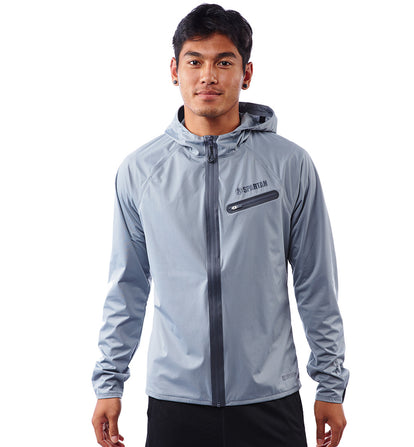Your Guide to Layering Like a Spartan: The Secret Temp Trick to Badass Winter Runs

Dressing for cooler temps is no joke. Every seasoned runner knows this truth: the forecast doesn’t always feel like it when you’re moving.
We’ve all been there. You layer up like a pro (or so you think), head out for a jog, sprints, intervals, whatever, and all of a sudden, you’re overheating, stripping off jackets and wondering what the hell to do with all those clothes. Or worse, you underestimate how chilly it really is and no matter how hard you run, you’re miserable and maybe even cutting it short.
So, here's the Spartan-approved guide for layering up to run in the cold. Plus, the epic secret to gauging outdoor temps so you can crush winter runs — no matter the weather, or the time of day — like the dedicated, persevering Spartan champ you are.
Is Running in the Cold Risky?
Nope. Not at all — as long as you dress appropriately. You’re going to sweat, and sweat equals moisture. Moisture, if not properly ventilated, means a dampness buildup. A little wetness is normal. But when you slow down or stop, you’ll cool down quickly. If you’re stuck in wet clothing, this can become uncomfortable and, if you stay outside, even lead to hypothermia. No bueno. The trick is to get indoors and strip off the wet layers ASAP. And if you’re going to work out outside and head to another location without a hot shower in between, bring an extra change of clothes.
Bonus Tip: On super cold days, do a dynamic warmup inside — like 5-7 minutes of high knees, push ups, sit ups, and burpees — to ensure you’re not exposing yourself to cramping or injury that comes with bolting from the couch to 10-degree weather.
The Rule of Thumb for Outdoor Running: Add 10-20 Degrees to the Outside Temp

Layering up properly helps regulate your body temperature during your runs. But how do you gauge how the actual temperature will impact your performance? Add 10-20 degrees to the outside temp to calculate how you’ll feel when you’re running, based on how much you tend to sweat and how hot you typically get. So let’s say it’s 30 degrees outside. Add 10 degrees (if you do overheat) or 20 degrees (if you don’t), which brings you to 40 or 50 degrees respectively. Also, take windchill into account. If it’s 30 degrees outside but the windchill is 20 (real feel), use 20 degrees as your base number to estimate up from that. A 20-degree windchill on a 30-degree day will feel like 30-40 degrees when you’re running. Then, dress for that.
In short, if you’re the guy who sweats buckets indoors at the gym, it’s safe to say, you can sneak by on dressing 10 degrees up from the outdoor temperature or windchill. If you’re always cold and find yourself layering up indoors, add 20 degrees, just to be safe.
The Basics of Layering
Your core is key. It goes without saying, but base layers should be next to your skin. Then, add a vest or light jacket or hoody, then, your precipitation layer. All should be thermoregulated, well-ventilated (with mesh escape panels for heat to move up and out), and consist of sweat-wicking, moisture-control fabrics like wool, polyester or polyamide. Spartan by CRAFT performance apparel ticks all of these boxes. Designed for OCR athletes by OCR athletes, it’s designed and tested by pros at northern Swedish altitudes that boast the coldest, darkest winter days. Bottom line: it works in Sweden, so you can trust it in U.S. winters.
Then, comes your head. You’ve probably heard the old adage that 80% of your body heat is off gassed through your noggin. This may not be entirely true, but a recent study in Front Neurosci found that the core brain temperature is higher than core body temperature and correlates with it. Simply put, if you’ve got a warm head, you’ve got a warmer body. So hats, headbands or any type of stocking cap is essential on colder days — anything below 45-50 degrees (running temperature). Not so, for your fingers. Your body pulls heat from its extremities to keep your internal organs in your core warm, so in chillier runs around 30-35 degrees (running temperature) gloves aren’t a bad idea.
Remember: it’s always best to have more layers than less. (Think: better safe than sorry.) But you can also avoid having to ditch layers behind a tree or your car on loop runs (which only slows you down and throws off your cadence) by estimating your running temperature correctly.
Running in the Cold: The Best Gear For Layering Up Like a Spartan
YOUR HEAD
Light Thermal Hat
On chilly days where full coverage is necessary, opt for the Light Thermal Hat. It’s thin and (true to its name) lightweight, but is made of a polyester/elastane blend that’s engineered to keep your head warm and transport moisture at the same time.
Thermal Headband
For warm(er) winter days, the Thermal Headband is a nice compromise. It fits snugly to your head keeping your ears warm but allows your scalp to breathe. A warm inner thermal polyester fabric feels cozy and it’s ultra lightweight so you’ll barely notice it’s there. (Also, athlete hack: it’s a nice way to keep your earbuds in place on day runs and athletes with long hair will love it.)
Related: Extreme Training: The Ultimate Tech Apparel for All-Things Winter Workouts
YOUR CORE
The Base Layer: Active Intensity LS Top
Ideal for layering in cold weather conditions, the Active Intensity LS Top is prime for next-to-skin thermoregulation. It fits close to your body, wicks sweat like a pro, and the seamless design reduces unwanted underarm chafing, allowing for optimal freedom of movement.
The Vest: SubZ Body Warmer
A vest is the way to go for warmer winter runs as a standalone outer layer. The SubZ Body Warmer has heat-bonded quilting at the front to shield you from the elements, and brushed perforated jersey at the lower back and neck for moisture control, warmth and protection. A hidden zip pocket is the perfect place to stash your keys, and reflective tape makes you visible in traffic so you can work out worry-free.
The Jacket: Urban Run Hydro Jacket
When it comes to running jackets, nothing can be sacrificed in warmth, moisture control and protection from precipitation. The Urban Run Hydro Jacket answers the call. Wind- and waterproof polyester/polyurethane blend keeps snow and rain out, and heat in. Taped seams at the neck and arm holes double down on protection, just to be sure. The hood can be snapped into place or worn around your head and face, and laser-cut ventilation at the arm pits allows unnecessary heat to escape so you’re comfortable all run long.
Related: The Ultimate Baselayer, Hoody and Jacket Guide for Winter Workouts
YOUR LEGS
The Leggings: Delta Warm Tight
The Delta Warm Tight comes with a graduated compression feature, which supports your muscles, encourages blood flow, and provides warmth and stability at the same time. Runners with shin splints, IT-band tightness or previous knee injuries will love this tight. Superior stretch and reflective patterning at the base make you visible and free to move without hindrance.















